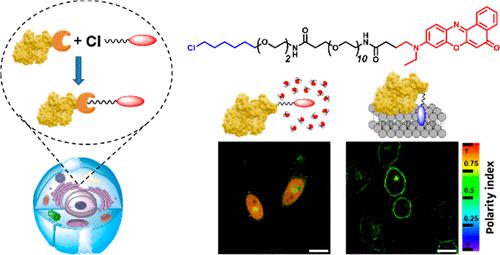当前位置:
X-MOL 学术
›
Anal. Chem.
›
论文详情
Our official English website, www.x-mol.net, welcomes your feedback! (Note: you will need to create a separate account there.)
Genetic Targeting of Solvatochromic Dyes for Probing Nanoscale Environments of Proteins in Organelles
Analytical Chemistry ( IF 7.4 ) Pub Date : 2023-05-25 , DOI: 10.1021/acs.analchem.3c00515 Rémi Pelletier 1 , Dmytro I Danylchuk 1 , Hela Benaissa 2 , Fanny Broch 2 , Romain Vauchelles 1 , Arnaud Gautier 2 , Andrey S Klymchenko 1
Analytical Chemistry ( IF 7.4 ) Pub Date : 2023-05-25 , DOI: 10.1021/acs.analchem.3c00515 Rémi Pelletier 1 , Dmytro I Danylchuk 1 , Hela Benaissa 2 , Fanny Broch 2 , Romain Vauchelles 1 , Arnaud Gautier 2 , Andrey S Klymchenko 1
Affiliation

|
A variety of protein tags are available for genetically encoded protein labeling, which allow their precise localization and tracking inside the cells. A new dimension in protein imaging can be offered by combining protein tags with polarity-sensitive fluorescent probes, which provide information about local nanoscale environments of target proteins within the subcellular compartments (organelles). Here, we designed three fluorescent probes based on solvatochromic nile red dye, conjugated to a HaloTag reactive targeting group through polyethylene glycol linkers of varying lengths. The probe with medium linker length, NR12-Halo, was found to label specifically a large variety of proteins localized in defined cell compartments, such as plasma membranes (outer and inner leaflets), endoplasmic reticulum, Golgi apparatus, cytosol, microtubules, actin, and chromatin. Owing to its polarity-sensitive fluorophore, the probe clearly distinguished the proteins localized within apolar lipid membranes from other proteins. Moreover, it revealed dramatic changes in the environment during the life cycle of proteins from biosynthesis to their expected localization and, finally, to recycling inside lysosomes. Heterogeneity in the local polarity of some membrane proteins also suggested a formation of low-polar protein aggregates, for example, within cell–cell contacts. The approach also showed that mechanical stress (cell shrinking by osmotic shock) induced a general polarity decrease in membrane proteins, probably due to the condensation of biomolecules. Finally, the nanoenvironment of some membrane proteins was affected by a polyunsaturated fatty acid diet, which provided the bridge between organization of lipids and proteins. The developed solvatochromic HaloTag probe constitutes a promising tool for probing nanoscale environments of proteins and their interactions within subcellular structures.
中文翻译:

溶剂化显色染料的遗传靶向,用于探测细胞器中蛋白质的纳米级环境
多种蛋白质标签可用于基因编码的蛋白质标记,从而允许它们在细胞内进行精确定位和追踪。通过将蛋白质标签与极性敏感荧光探针相结合,可以提供蛋白质成像的新维度,这些探针提供有关亚细胞区室(细胞器)内目标蛋白质的局部纳米级环境的信息。在这里,我们设计了三种基于溶剂化显色尼罗红染料的荧光探针,通过不同长度的聚乙二醇接头与 HaloTag 反应性靶向基团结合。发现具有中等接头长度的探针 NR12-Halo 可以特异性标记定位于特定细胞区室中的多种蛋白质,例如质膜(外叶和内叶)、内质网、高尔基体、胞质溶胶、微管、肌动蛋白、和染色质。由于其对极性敏感的荧光团,该探针可以清楚地区分位于非极性脂质膜内的蛋白质与其他蛋白质。此外,它揭示了蛋白质从生物合成到预期定位,最后到溶酶体内循环的生命周期中环境的巨大变化。一些膜蛋白局部极性的异质性也表明低极性蛋白聚集体的形成,例如,在细胞-细胞接触中。该方法还表明,机械应力(渗透休克引起的细胞收缩)导致膜蛋白的极性普遍降低,这可能是由于生物分子的凝聚。最后,一些膜蛋白的纳米环境受到多不饱和脂肪酸饮食的影响,它提供了脂质和蛋白质组织之间的桥梁。开发的溶剂化显色 HaloTag 探针构成了一种很有前途的工具,用于探测蛋白质的纳米级环境及其在亚细胞结构中的相互作用。
更新日期:2023-05-25
中文翻译:

溶剂化显色染料的遗传靶向,用于探测细胞器中蛋白质的纳米级环境
多种蛋白质标签可用于基因编码的蛋白质标记,从而允许它们在细胞内进行精确定位和追踪。通过将蛋白质标签与极性敏感荧光探针相结合,可以提供蛋白质成像的新维度,这些探针提供有关亚细胞区室(细胞器)内目标蛋白质的局部纳米级环境的信息。在这里,我们设计了三种基于溶剂化显色尼罗红染料的荧光探针,通过不同长度的聚乙二醇接头与 HaloTag 反应性靶向基团结合。发现具有中等接头长度的探针 NR12-Halo 可以特异性标记定位于特定细胞区室中的多种蛋白质,例如质膜(外叶和内叶)、内质网、高尔基体、胞质溶胶、微管、肌动蛋白、和染色质。由于其对极性敏感的荧光团,该探针可以清楚地区分位于非极性脂质膜内的蛋白质与其他蛋白质。此外,它揭示了蛋白质从生物合成到预期定位,最后到溶酶体内循环的生命周期中环境的巨大变化。一些膜蛋白局部极性的异质性也表明低极性蛋白聚集体的形成,例如,在细胞-细胞接触中。该方法还表明,机械应力(渗透休克引起的细胞收缩)导致膜蛋白的极性普遍降低,这可能是由于生物分子的凝聚。最后,一些膜蛋白的纳米环境受到多不饱和脂肪酸饮食的影响,它提供了脂质和蛋白质组织之间的桥梁。开发的溶剂化显色 HaloTag 探针构成了一种很有前途的工具,用于探测蛋白质的纳米级环境及其在亚细胞结构中的相互作用。



























 京公网安备 11010802027423号
京公网安备 11010802027423号